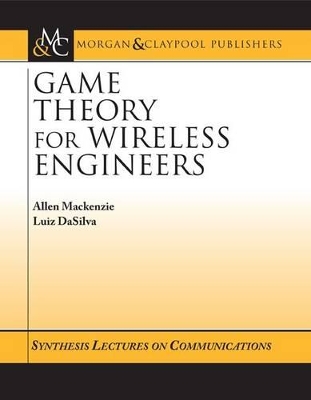Synthesis Lectures on Communications
2 total works
Game Theory for Wireless Engineers
by Allen B MacKenzie and Luiz A Dasilva
Published 1 February 2006
The application of mathematical analysis to wireless networks has met with limited success, due to the complexity of mobility and traffic models, coupled with the dynamic topology and the unpredictability of link quality that characterize such networks. The ability to model individual, independent decision makers whose actions potentially affect all other decision makers makes game theory particularly attractive to analyze the performance of ad hoc networks.
Game theory is a field of applied mathematics that describes and analyzes interactive decision situations. It consists of a set of analytical tools that predict the outcome of complex interactions among rational entities, where rationality demands a strict adherence to a strategy based on perceived or measured results. In the early to mid-1990's, game theory was applied to networking problems including flow control, congestion control, routing and pricing of Internet services. More recently, there has been growing interest in adopting game-theoretic methods to model today's leading communications and networking issues, including power control and resource sharing in wireless and peer-to-peer networks.
This work presents fundamental results in game theory and their application to wireless communications and networking. We discuss normal-form, repeated, and Markov games with examples selected from the literature. We also describe ways in which learning can be modeled in game theory, with direct applications to the emerging field of cognitive radio. Finally, we discuss challenges and limitations in the application of game theory to the analysis of wireless systems. We do not assume familiarity with game theory. We introduce major game theoretic models and discuss applications of game theory including medium access, routing, energy-efficient protocols, and others. We seek to provide the reader with a foundational understanding of the current research on game theory applied to wireless communications and networking.
Game theory is a field of applied mathematics that describes and analyzes interactive decision situations. It consists of a set of analytical tools that predict the outcome of complex interactions among rational entities, where rationality demands a strict adherence to a strategy based on perceived or measured results. In the early to mid-1990's, game theory was applied to networking problems including flow control, congestion control, routing and pricing of Internet services. More recently, there has been growing interest in adopting game-theoretic methods to model today's leading communications and networking issues, including power control and resource sharing in wireless and peer-to-peer networks.
This work presents fundamental results in game theory and their application to wireless communications and networking. We discuss normal-form, repeated, and Markov games with examples selected from the literature. We also describe ways in which learning can be modeled in game theory, with direct applications to the emerging field of cognitive radio. Finally, we discuss challenges and limitations in the application of game theory to the analysis of wireless systems. We do not assume familiarity with game theory. We introduce major game theoretic models and discuss applications of game theory including medium access, routing, energy-efficient protocols, and others. We seek to provide the reader with a foundational understanding of the current research on game theory applied to wireless communications and networking.
A Tutorial on Queuing and Trunking with Applications to Communications
by William Tranter and Allen B MacKenzie
Published 1 November 2012
The motivation for developing this synthesis lecture was to provide a tutorial on queuing and trunking, with extensions to networks of queues, suitable for supplementing courses in communications, stochastic processes, and networking. An essential component of this lecture is MATLAB-based demonstrations and exercises, which can be easily modified to enable the student to observe and evaluate the impact of changing parameters, arrival and departure statistics, queuing disciplines, the number of servers, and other important aspects of the underlying system model. Much of the work in this lecture is based on Poisson statistics, since Poisson models are useful due to the fact that Poisson models are analytically tractable and provide a useful approximation for many applications. We recognize that the validity of Poisson statistics is questionable for a number of networking applications and therefore we briefly discuss self-similar models and the Hurst parameter, long-term dependent models, the Pareto distribution, and other related topics. Appropriate references are given for continued study on these topics.
The initial chapters of this book consider individual queues in isolation. The systems studied consist of an arrival process, a single queue with a particular queuing discipline, and one or more servers. While this allows us to study the basic concepts of queuing and trunking, modern data networks consist of many queues that interact in complex ways. While many of these interactions defy analysis, the final chapter introduces a model of a network of queues in which, after being served in one queue, customers may join another queue. The key result for this model is known as Jackson's Theorem. Finally, we state the BCMP Theorem, which can be viewed as a further extension of Jackson's Theorem and present Kleinrock's formula, which can be viewed as the network version of Little's Theorem.
The initial chapters of this book consider individual queues in isolation. The systems studied consist of an arrival process, a single queue with a particular queuing discipline, and one or more servers. While this allows us to study the basic concepts of queuing and trunking, modern data networks consist of many queues that interact in complex ways. While many of these interactions defy analysis, the final chapter introduces a model of a network of queues in which, after being served in one queue, customers may join another queue. The key result for this model is known as Jackson's Theorem. Finally, we state the BCMP Theorem, which can be viewed as a further extension of Jackson's Theorem and present Kleinrock's formula, which can be viewed as the network version of Little's Theorem.

